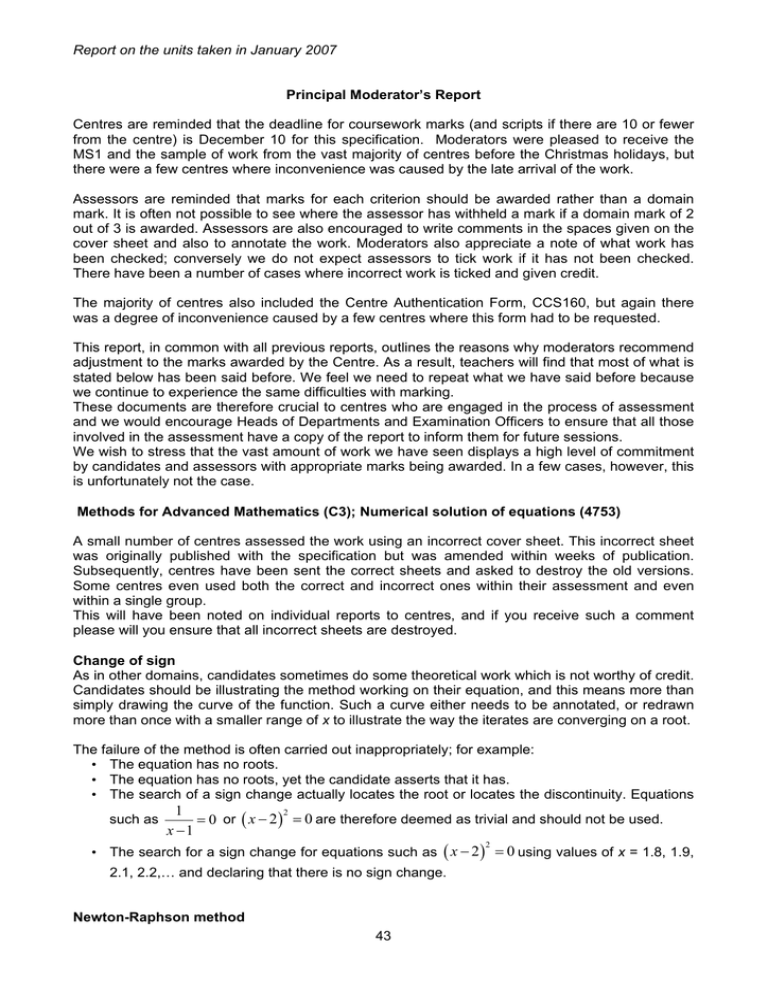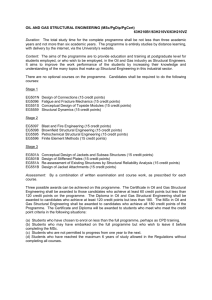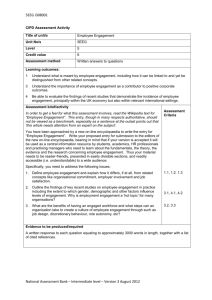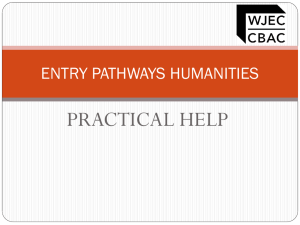Document 10488704
advertisement

Report on the units taken in January 2007 Principal Moderator’s Report Centres are reminded that the deadline for coursework marks (and scripts if there are 10 or fewer from the centre) is December 10 for this specification. Moderators were pleased to receive the MS1 and the sample of work from the vast majority of centres before the Christmas holidays, but there were a few centres where inconvenience was caused by the late arrival of the work. Assessors are reminded that marks for each criterion should be awarded rather than a domain mark. It is often not possible to see where the assessor has withheld a mark if a domain mark of 2 out of 3 is awarded. Assessors are also encouraged to write comments in the spaces given on the cover sheet and also to annotate the work. Moderators also appreciate a note of what work has been checked; conversely we do not expect assessors to tick work if it has not been checked. There have been a number of cases where incorrect work is ticked and given credit. The majority of centres also included the Centre Authentication Form, CCS160, but again there was a degree of inconvenience caused by a few centres where this form had to be requested. This report, in common with all previous reports, outlines the reasons why moderators recommend adjustment to the marks awarded by the Centre. As a result, teachers will find that most of what is stated below has been said before. We feel we need to repeat what we have said before because we continue to experience the same difficulties with marking. These documents are therefore crucial to centres who are engaged in the process of assessment and we would encourage Heads of Departments and Examination Officers to ensure that all those involved in the assessment have a copy of the report to inform them for future sessions. We wish to stress that the vast amount of work we have seen displays a high level of commitment by candidates and assessors with appropriate marks being awarded. In a few cases, however, this is unfortunately not the case. Methods for Advanced Mathematics (C3); Numerical solution of equations (4753) A small number of centres assessed the work using an incorrect cover sheet. This incorrect sheet was originally published with the specification but was amended within weeks of publication. Subsequently, centres have been sent the correct sheets and asked to destroy the old versions. Some centres even used both the correct and incorrect ones within their assessment and even within a single group. This will have been noted on individual reports to centres, and if you receive such a comment please will you ensure that all incorrect sheets are destroyed. Change of sign As in other domains, candidates sometimes do some theoretical work which is not worthy of credit. Candidates should be illustrating the method working on their equation, and this means more than simply drawing the curve of the function. Such a curve either needs to be annotated, or redrawn more than once with a smaller range of x to illustrate the way the iterates are converging on a root. The failure of the method is often carried out inappropriately; for example: • The equation has no roots. • The equation has no roots, yet the candidate asserts that it has. • The search of a sign change actually locates the root or locates the discontinuity. Equations 2 1 = 0 or ( x − 2 ) = 0 are therefore deemed as trivial and should not be used. x −1 2 • The search for a sign change for equations such as ( x − 2 ) = 0 using values of x = 1.8, 1.9, such as 2.1, 2.2,… and declaring that there is no sign change. Newton-Raphson method 43 Report on the units taken in January 2007 It is unnecessary for candidates to derive the formula as there is no credit for doing so. However, it is necessary to describe by graphical illustration how the method works, and, as with the last domain, this illustration should be using the equation being solved. The second mark in this domain is for finding all remaining roots, the first mark being for the first root. If there is only one root then this mark should not be awarded. The requirements of the task include the need for the equation to be used in this domain to have at least two roots (see specification book, page 62). A candidate who uses an equation with only one root should therefore not be awarded this second mark. Error bounds need to be established. It is not enough to note that successive iterates agree to n decimal places and that therefore the root is found to n decimal places. Error bounds are typically established by a change of sign calculation. The need to illustrate failure of the method to converge to an expected root is “despite a starting value close to it”. Merely choosing an unrealistic value for x0 does not satisfy this criterion. Typically, a candidate will embark on this method by doing a sign change search using integer values, thus locating the integer interval for each root. It is therefore reasonable to take one of the integer end points as a starting value. Particularly in this domain, candidates who use computer resources to do the work for them should give some indication that they understand the method by doing some of the work themselves, either using a spreadsheet or calculator. Rearrangement method The main problem in this domain was the description of why convergence or not was achieved. It is expected that candidates will make some reference to the fact that the gradient of the line y = x is 1 and that convergence will therefore only be achieved if g '( x ) < 1 . Merely stating that g '( x ) < 1 with no explanation does not fulfil the criterion. The moderators spotted some work given credit in this domain, but the rearrangement was incorrect, thus yielding a value for a root that was incorrect. Comparison It is expected that candidates will find a particular root already found by one of the methods by the other two methods, using the same starting value. Without this condition, any comparison of speed of convergence is a little limited. Candidates are also expected to comment on the resources (hardware and software) they have used. Candidates who have used spreadsheets and/or “Autograph” may well come to an entirely different conclusion from candidates who have only had a scientific calculator at their disposal. Written communication Some candidates find it difficult to write equations and functions well enough for the reader to understand what is being said, and to relate what they are writing to the curves they are drawing. Such candidates should be penalised in this domain. Rather more particularly, many candidates confuse equations with functions and even expressions. A candidate who writes “I am going to solve the equation y = x3 + x − 7” or even “I am going to solve the equation x3 + x − 7” should not be credited with having written correct notation and terminology. The moderators found that a large number of candidates were awarded this mark with a positive comment given, yet the work was full of the confusions described above. 44 Report on the units taken in January 2007 Oral communication As with the investigations in the other two units, it is a requirement that the assessor fulfils this criterion and writes a brief report on how it was done and the results. Assessors are reminded that it is not permissible to give credit for any of the other criteria as a result of this oral communication. Differential Equations (4758) Fewer changes were made to the submitted marks this season. The usual tasks were submitted along with one or two original tasks. Teachers should note the following points which contributed to the generosity of marking. In domain 3, the source of the data often needs to be explicit, together with some discussion of accuracy. (This is particularly so in the task “Aeroplanes”.) A comparison of predicted and measured values, in the form of a table, should be included wherever possible, while it is accepted that this is not always possible or sensible. Students should be encouraged to label graphs clearly; it is not always evident to the reader whether the values shown are measured or predicted. A crucial part of the task is to demonstrate the modelling cycle. Care must therefore be taken to ensure that the second model is a revision of the first rather than a new model for a new situation. New and original investigations are encouraged, but again, care must be taken to ensure that the modelling cycle of comparison and revision of the original model is possible. Numerical Methods (4776) Most candidates tackled suitable problems, mainly on numerical integration, but a few were disadvantaged by the choice of topic which meant that they were unable to address the criteria adequately. Rather more marks were adjusted this session than is usual. In many cases this was because incorrect work was being given credit. An example is in numerical integration where, for a well-behaved curve, there is a theoretical value to which the ratio of differences of the area found by a standard procedure (midpoint, trapezium or Simpson’s rules) will converge. Candidates were being given full credit for using this theoretical value even when there was no justification from their work to do so. In addition, if the curve is not well-behaved, then the value is actually wrong and the use of such a value will lead to errors in the solution of the problem. If such work is given full credit then there is a generosity of marks of at least 2 in the error analysis domain and at least 2 in the interpretation domain. Other problems in assessment experienced by the moderators are outlined below. Domain 1. If all the candidates from a centre do much the same task using the same template then it is difficult to justify the first mark which is for a candidate to identify a suitable problem. Additionally it is expected that a brief explanation of why it is an appropriate problem is expected. (In the case of numerical integration it is not expected that candidates will attempt to justify this by “trying” standard methods of integration known to him/her.) It is worth noting that at this level and in this task, creating artificial contexts does little to enhance the task - our experience is that more usually it causes confusion to the candidate. 45 Report on the units taken in January 2007 Domain 2. It is not necessary to describe the methods or reproduce mere bookwork to explain how the methods work. In this domain it is sufficient to explain why the procedure was used. Many candidates doing numerical integration chose all three procedures without any justification or explanation and were given full credit. Domain 3. In a few cases, full credit was given to candidates whose work could not be classified as “substantial”. In the case of numerical integration and Simpson’s rule, for instance, we would expect to see S2, S4, S8, S16, S32, S64 and possibly also S128 in order to justify convergence of r. Obtaining only up to S32, or perhaps a single application to find S128 would not be enough to satisfy the other criteria. While it is not expected that assessors will check all the work of all their candidates, there was evidence that incorrect work had been ticked, and this was particularly so in numerical integration. Domain 4. The wording of the criteria should make it clear that it is expected that spreadsheets be used. There are still a few centres where candidates have completed their work on calculators and in these cases the criteria in this domain are difficult to obtain. Where a spreadsheet is used, a printout of formulae used needs to be annotated to explain what is being done. Domain 5. Many candidates working on numerical integration were given credit for work that was incomplete or incorrect. Candidates who obtained a ratio of differences that looked as though r was converging to 0.35, but then used a theoretical value of 0.0625 to extrapolate has not got the application fully correct and the subsequent analysis will be wrong. Likewise, candidates who do not work through the ratio of differences but uses r = 0.0625 has not got the application fully correct and may get the analysis wrong. There are some integrals which may be theoretically outside the experience of the candidate at this particular point of their career and there may be some integrals which can now be found using an algebraic manipulator (such as “Derive”) and as a result, candidates may have an alternative means of obtaining an accurate value for their integral. In some cases candidates have taken this value and used it in their error analysis. For this piece of coursework this is inappropriate; error analysis should be worked from within their calculations. Thus, working out differences and then ratio of differences for numerical integration is appropriate, while error from some other (assumed correct) value is not. Domain 6. Where there is incorrect work as outlined above, marks for accuracy of solution are also difficult to justify. 46 Report on the units taken in January 2007 7895-8, 3895-8 AS and A2 MEI Mathematics January 2007 Assessment Series Unit Threshold Marks Unit All units UMS Maximum Mark 100 A B C D E U 80 70 60 50 40 0 4751 Raw 72 50 43 36 29 23 0 4752 Raw 72 52 45 38 31 25 0 4753 Raw 72 61 54 47 39 31 0 4753/02 Raw 18 14 12 10 9 8 0 4754 Raw 90 68 60 52 44 37 0 4755 Raw 72 59 51 43 35 27 0 4756 Raw 72 53 46 39 32 25 0 4758 Raw 72 58 50 42 33 24 0 4758/02 Raw 18 14 12 10 9 8 0 4761 Raw 72 56 48 40 33 26 0 4762 Raw 72 58 50 43 36 29 0 4763 Raw 72 53 46 39 32 25 0 4766 Raw 72 51 44 38 32 26 0 4767 Raw 72 59 52 45 38 31 0 4768 Raw 72 59 51 43 35 28 0 4771 Raw 72 55 47 40 33 26 0 4776 Raw 72 52 46 40 33 27 0 4776/02 Raw 18 13 11 9 8 7 0 Specification Aggregation Results Overall threshold marks in UMS (i.e. after conversion of raw marks to uniform marks) A B C D E U 7895-7898 Maximum Mark 600 480 420 360 300 240 0 3895-3898 300 240 210 180 150 120 0 47 Report on the units taken in January 2007 The cumulative percentage of candidates awarded each grade was as follows: A B C D E U 7895 28.9 59.8 83.5 95.9 96.9 100 Total Number of Candidates 97 7896 30.8 69.2 100 100 100 100 13 7897 100 100 100 100 100 100 1 0 7898 3895 18.0 39.1 61.6 78.4 94.4 100 445 3896 33.3 66.7 83.3 100 100 100 6 3897 100 100 100 100 100 100 2 3898 84.6 92.3 92.3 100 100 100 13 For a description of how UMS marks are calculated see; http://www.ocr.org.uk/exam_system/understand_ums.html Statistics are correct at the time of publication 48







